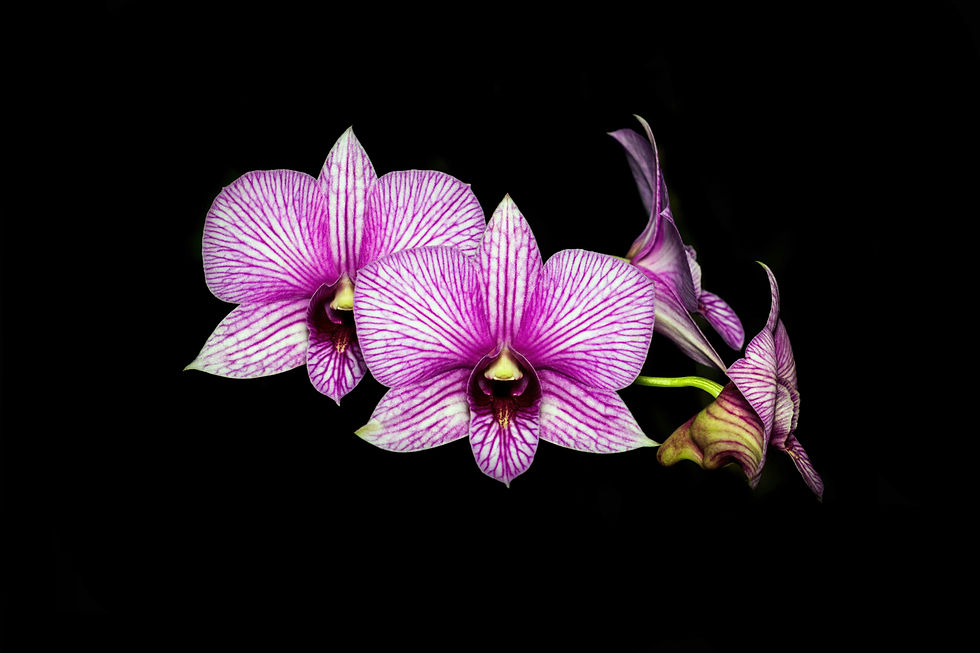How to Choose the Perfect Orchid for Your Home
- Guna Orchids

- May 3
- 3 min read
When it comes to adding beauty to your home, few plants can rival orchids. Known for their stunning blooms and unique structures, orchids can truly elevate your interior decor. However, with so many varieties available, how do you choose the perfect orchid for your space? In this guide, we will explore the essential factors to consider, the types of orchids available, and tips for maintaining these exotic plants.
Identifying Your Perfect Orchid
Before diving into the specific types of orchids, it's essential to identify what you need. Ask yourself some key questions to narrow down your choices:
What is the light condition in your home?
How much time can you dedicate to plant care?
Are you looking for a flowering or foliage plant?
Understanding your space and personal habits will help you choose an orchid that thrives in your environment.

Types of Orchids: Finding Your Perfect Match
There are over 25,000 species of orchids, making selections plentiful. However, here are a few popular types to consider:
1. Phalaenopsis (Moth Orchid)
The Phalaenopsis orchid is perhaps the most recognizable type, often found in homes and offices. They are known for their attractive, long-lasting blooms and can flower multiple times a year with proper care. They thrive in medium to bright indirect light and enjoy a warm climate.
Care Tip: Water them every 7-10 days and ensure good drainage.
2. Cattleya Orchids
Cattleyas are known for their large, fragrant flowers, making them a favorite among orchid enthusiasts. They prefer bright light and are perfect for south-facing windows. These orchids can be a bit more challenging to care for but reward you with spectacular blooms.
Care Tip: Keep them moist but not soggy.
3. Dendrobium Orchids
Dendrobium orchids are diverse and can be suitable for beginners. They have a more bushy appearance and can bloom multiple times throughout the year. They thrive in bright, indirect sunlight and should be watered when the potting mix feels dry.
Care Tip: Fertilize every couple of weeks during the growing season.

4. Oncidium Orchids
Also known as “dancing lady” orchids, Oncidians have unique flower shapes and vibrant colors. They need bright indirect light and love humidity. They are suitable for people who can commit to a regular watering schedule.
Care Tip: Ensure you maintain humidity levels, which can be enhanced with misting or a humidity tray.
What is the price of orchids?
Orchid prices in India vary widely depending on the species, rarity, and whether you're purchasing potted plants or cut flowers. Common varieties like Phalaenopsis and Dendrobium orchids typically range from ₹300 to ₹2,500 per plant, while rarer species like Vanda and Paphiopedilum can cost between ₹1,000 to ₹5,000 or more. Cut orchid flowers, often sold by weight for floral arrangements, are priced around ₹450 to ₹500 per kg in major cities like Chennai, Mumbai, and Delhi. Buying in bulk or during orchid sale can also provide opportunities for discounts.
Positioning and Placement: Where to Put Your Orchid
Once you've selected your perfect orchid, location matters for its longevity and growth. Here are a few tips for placement:
Light: Most orchids thrive in bright, indirect sunlight. Avoid placing them in direct sunlight, as this can scorch their leaves.
Humidity: Orchids prefer humid environments. A bathroom with a window is often an ideal location, as it provides warmth and moisture.
Airflow: Ensure that your chosen spot has good airflow to prevent mold and fungal infections.

Caring for Your Orchid
Caring for your orchid doesn’t have to be complicated. Here are some essential tips:
1. Watering
Ensure you water your orchid just enough. Overwatering is a common mistake that can lead to root rot. A good rule of thumb is to water once a week, allowing the soil to dry out slightly between waterings.
2. Fertilizing
Fertilize your orchids with a balanced orchid fertilizer every month during the growing season. This supports healthy growth and flowering.
3. Potting Mix
Use a special orchid mix that allows for proper drainage and airflow. Regular potting soil is often too dense for orchids.
4. Pruning
After blooming, prune the flower spike just above a node to encourage new growth. This helps in maintaining the plant's health and encourages flowering in the next season.
Final Thoughts on Your Perfect Orchid
Choosing the perfect orchid for your home can be an enjoyable journey. By understanding the various types available and considering factors like care requirements and location, you can select a stunning plant that enhances your living space. Remember, patience is key when caring for your orchid, as some may take time to bloom.
Following the guidelines in this post will ensure that you provide the best home for your new orchid. Happy planting!



Comentarios